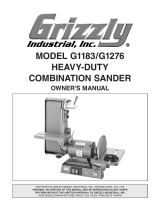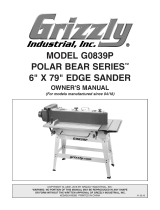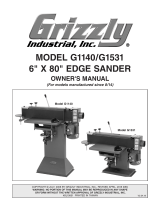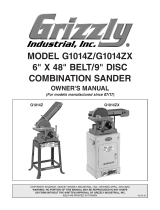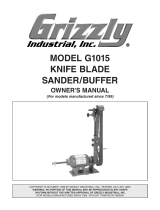Page is loading ...

For questions or help with this product contact Tech Support at (570) 546-9663 or techsupport@grizzly.com
MODEL T30883
SANDING DISC KIT
INSTRUCTIONS
COPYRIGHT © FEBRUARY, 2020 BY GRIZZLY INDUSTRIAL, INC.
NO PORTION OF THIS MANUAL MAY BE REPRODUCED IN ANY SHAPE
OR FORM WITHOUT THE WRITTEN APPROVAL OF GRIZZLY INDUSTRIAL, INC.
(FOR MODELS MFD. SINCE 01/20) #AI20953 PRINTED IN TAIWAN
Introduction Operation
The T30883 Sanding Disc Kit allows you to oper-
ate your Model G0869/G0870 Table Saw as a
disc sander. The steel platen accepts 10" PSA
sanding discs and mounts on
5
⁄8" arbors.
Install your sanding disc platen according to the
blade installation instructions in the G0869/G0870
owner's manual.
Replace sandpaper whenever it shows signs of
wear. Remove platen from table saw to replace
sandpaper.
When sanding, firmly grasp workpiece and sup-
port it on the table, then ease workpiece into
sandpaper with light pressure. Move workpiece
across wheel so that sandpaper wears evenly.
Sand on downward-moving half of disc (see
Figure 2) so that rotational force helps support
workpiece against table.
V1.02.20
The T30883 steel platen is designed for
use with the Model G0869 and G0870 table
saws. Do not modify or alter the platen
for use with any machine for which it isn't
designed. Doing so could result in property
damage or serious personal injury.
Workpiece
Figure 1. Steel platen with adhesive sanding
disc.
Figure 2. Proper workpiece placement.
WARNING: Always perform sanding opera-
tions at LOWEST speed settings on your saw.
Sanding at high speeds can result in damage to
the workpiece or sandpaper, which can result in
kickback and serious injury.

-2-
T30883 Sanding Disc Kit (Mfd. Since 01/20)
IN-RUNNING NIP POINTS. The gap between
moving sandpaper and table surface creates a
pinch point for fingers or workpieces. Be aware of
gap and keep small workpieces and hands away
from it when possible.
SANDPAPER CONDITION. Worn or damaged
sandpaper not only produces poor sanding results,
but could fly apart, aggressively grab workpiece,
and throw debris at the operator. Always inspect
sandpaper before operation and replace if worn or
damaged.
WORKPIECE INTEGRITY. Only sand solid
workpieces that can withstand power sanding
forces. Make sure shape of workpiece is prop-
erly supported on table; avoid sanding workpieces
without flat bottom surfaces unless some type of
jig is used to maintain support and control when
sanding force is applied.
PROPER PPE. Damage to your eyes, lungs, and
ears could result from using this item without
proper protective gear, such as safety glasses, a
respirator, and hearing protection. Always wear
proper safety equipment when sanding.
Serious injury or death can occur from fingers or hands contacting sandpaper, or from fingers,
clothes, or hair getting entangled in sanding disc. Follow ALL applicable table saw safety
when operating machine as a sander. In addition, anyone operating machine as a sander MUST
completely heed all hazards and warnings below.
DISC DIRECTION. Only sand on downward-
moving side of sanding disc. Sanding on upward-
moving side of sanding disc forces operator to rely
only on hands (rather than table) for support, which
increases risk of workpiece “kick-out” and impact/
abrasion injuries.
HAND PLACEMENT. Rotating sandpaper can
remove a large amount of flesh in a few seconds.
Always keep hands away from sandpaper during
operation. Never touch moving sandpaper on pur-
pose. Use a brush to clean table of sawdust and
chips.
FEEDING WORKPIECE. Forcefully jamming work-
piece into sanding surface could cause workpiece
to be aggressively grabbed and pull your hands
into sanding surface. Firmly grasp workpiece in
both hands and ease it into sandpaper using light
pressure.
MINIMUM STOCK DIMENSION. Small workpieces
can be aggressively pulled from your hands.
Always use a jig or other holding device when
sanding small workpieces, and keep hands and
fingers at least 2” away from sanding surface.
/
